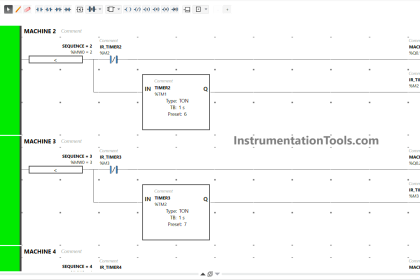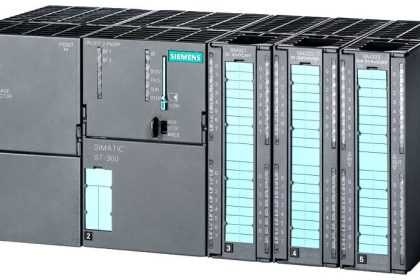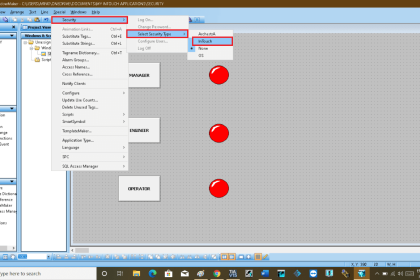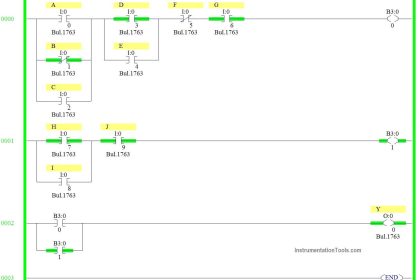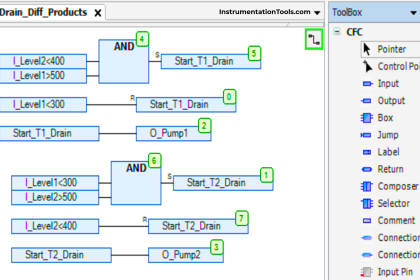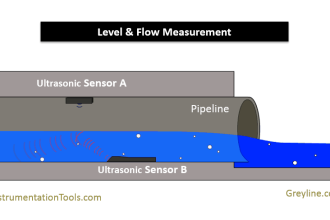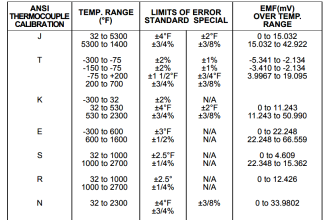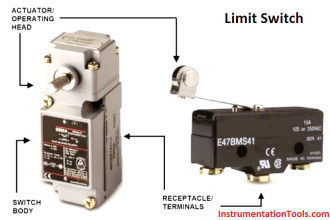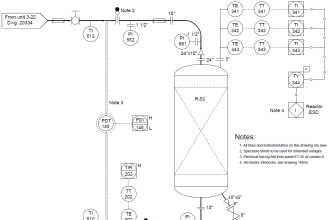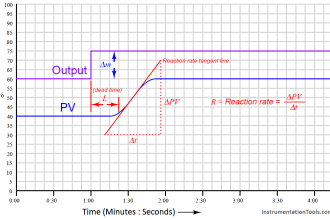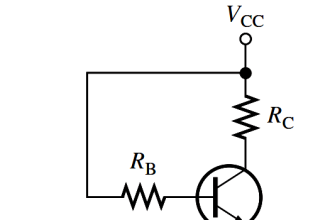Prepare for exams with our collection of 80+ PLC MCQ questions covering programmable logic controllers, and automation concepts.
PLC MCQ Questions
The PLC video shares the detailed explanations for the first 30 programmable logic controller questions.
Question 1
What does PLC stand for?
A. Process Logic Controller
B. Programmable Logic Controller
C. Programmed Logic Computer
D. Programmable Logical Container
Show the Answer
Programmable Logic Controller
Question 2
Which language is commonly used for PLC programming?
A. JavaScript
B. Ladder Logic
C. C++
D. Python
Show the Answer
Ladder Logic
Question 3
What is the primary function of a PLC?
A. Networking
B. Process automation
C. Autonomous vehicle control
D. Data storage and analysis
Show the Answer
Process automation
Question 4
What does the term “ladder” in ladder logic refer to?
A. The hierarchy of operations
B. The steps in debugging
C. The sequential steps of a process
D. The structure resembling rungs on a ladder
Show the Answer
The structure resembling rungs on a ladder
Question 5
What does the abbreviation SCADA stand for in relation to PLC systems?
A. Secure Control and Data Access
B. System Control and Data Acquisition
C. Supervisory Control and Digital Acquisition
D. Supervisory Control and Data Acquisition
Show the Answer
Supervisory Control and Data Acquisition
Question 6
Which component of a PLC executes the control program?
A. Power Supply
B. CPU
C. I/O Modules
D. Communication Interface
Show the Answer
CPU
Question 7
What kind of memory is typically used to store a PLC’s program in latest models?
A. RAM
B. Hard Disk
C. ROM
D. Flash Memory
Show the Answer
Flash Memory
Question 8
What is the role of I/O modules in a PLC system?
A. Handling input signals only
B. Handling input and output signals
C. Processing data
D. Storing data
Show the Answer
Handling input and output signals
Question 9
Which of the following is NOT a typical application of PLCs?
A. Home appliance control
B. Robotics control
C. Traffic light control
D. Industrial automation
Show the Answer
Home appliance control
Question 10
What type of signal does a PLC digital input module process?
A. RF signals
B. Digital signals
C. Analog signals
D. Infrared signals
Show the Answer
Digital signals
Try these for best PLC questions:
Question 11
Which PLC feature allows it to continue operating despite minor faults?
A. Scalability
B. Compatibility
C. Redundancy
D. Modularity
Show the Answer
Redundancy
Question 12
Which of the following is a common communication protocol used by PLCs?
A. HTTP
B. Modbus
C. FTP
D. MQTT
Show the Answer
Modbus
Question 13
What is the purpose of a PLC’s HMI (Human-Machine Interface)?
A. Software development
B. Data analysis
C. User interaction with the PLC system
D. Network management
Show the Answer
User interaction with the PLC system
Question 14
What does the term “scan time” refer to in a PLC?
A. The time it takes to save the program to memory
B. The time it takes to complete one cycle of reading inputs, executing the program, and updating outputs
C. The time it takes to complete one cycle of reading outputs, executing the program, and updating inputs
D. The time it takes to boot up the PLC
Show the Answer
The time it takes to complete one cycle of reading inputs, executing the program, and updating outputs
Question 15
What is ladder logic primarily based on?
A. Flowcharts
B. Boolean algebra
C. Sequential programming
D. Electrical relay logic
Show the Answer
Electrical relay logic
Question 16
Which of these is NOT an advantage of using PLCs when compared to traditional electrical circuits?
A. Low initial cost
B. High reliability
C. Flexibility in programming
D. Easy troubleshooting
Show the Answer
Low initial cost
Question 17
In a PLC analog control loop, what is an actuator typically responsible for?
A. Detecting physical changes
B. Reading sensors values
C. Executing physical actions
D. Measuring temperature
Show the Answer
Executing physical actions
Question 18
What is the primary benefit of using a PLC over traditional relay control systems?
A. Faster network speeds
B. Lower power consumption
C. Higher data storage capacity
D. Greater flexibility and programmability
Show the Answer
Greater flexibility and programmability
Question 19
How are analog signals processed by a PLC?
A. Through special communication modules
B. Directly through digital I/O modules
C. By converting them to digital signals
D. By converting them to analog signals
Show the Answer
By converting them to digital signals
Question 20
Which type of PLC memory is volatile and loses data when power is off?
A. RAM
B. EEPROM
C. ROM
D. Flash memory
Show the Answer
RAM
Check these for complex PLC questions:
Question 21
What does the term “hot-swapping” refer to in PLC systems?
A. Reprogramming the PLC during operation without the shutdown
B. Changing I/O modules without shutting down the system
C. Upgrading the CPU in shutdown time only
D. Updating the firmware online to the latest version
Show the Answer
Changing I/O modules without shutting down the system
Question 22
Which PLC component is responsible for interfacing with sensors and actuators?
A. I/O modules
B. Power supply
C. CPU
D. Communication module
Show the Answer
I/O modules
Question 23
What is the role of a watchdog timer in a PLC?
A. Measure execution time of the PLC program
B. Monitor and reset the PLC if the program fails
C. Synchronize the PLC with external devices
D. Only monitors the PLC if the program fails
Show the Answer
Monitor and reset the PLC if the program fails
Question 24
Which of the following is an example of a discrete input device for a PLC?
A. Flow meter
B. Proximity switch
C. Pressure sensor
D. Thermocouple
Show the Answer
Proximity switch
Question 25
In PLC terminology, what is a “bit” commonly referred to as?
A. Instruction
B. Byte
C. Word
D. Contact
Show the Answer
Contact
Question 26
What type of signal is typically managed by an analog input module in a PLC?
A. RF signals
B. Digital signals
C. Variable voltage or current signals
D. PWM signals
Show the Answer
Variable voltage or current signals
Question 27
Which PLC feature allows it to communicate with other PLCs and devices?
A. Memory modules
B. I/O modules
C. Network protocols
D. CPU
Show the Answer
Network protocols
Question 28
In a PLC, what is the function of a “timer“?
A. Measure and control time intervals
B. Store program data
C. Convert analog signals to digital
D. Control the execution speed
Show the Answer
Measure and control time intervals
Question 29
What is the main purpose of using sensors with PLCs?
A. To process control logic
B. To convert digital signals to analog
C. To store data
D. To detect and send input signals
Show the Answer
To detect and send input signals
Question 30
What does “modular PLC” mean?
A. A PLC with a fixed number of I/O points
B. A PLC with built-in HMI
C. A PLC that supports wireless communication
D. A PLC that allows adding/removing modules
Show the Answer
A PLC that allows adding/removing modules
Learning PLC Basics
The below video shares the correct explanations for the next 30 PLC questions.
Question 31
What is a common characteristic of PLCs used in safety-critical applications?
A. Compact size
B. Redundant systems
C. High capacity memory
D. High speed
Show the Answer
Redundant systems
Question 32
Which of the following is an advantage of using modular PLCs?
A. Limited expansion options
B. Fixed I/O configuration
C. Hardwired programming
D. Scalability and flexibility
Show the Answer
Scalability and flexibility
Question 33
What is the function of an Analog-to-Digital Converter (ADC) in a PLC?
A. Control output signals
B. Store digital data
C. Convert digital signals to analog
D. Convert analog signals to digital
Show the Answer
Convert analog signals to digital
Question 34
What type of PLC is typically used for small-scale applications?
A. Modular PLC
B. Compact PLC
C. Distributed PLC
D. Rack-mounted PLC
Show the Answer
Compact PLC
Question 35
What does “real-time processing” mean in the PLC?
A. Processing data in batch mode
B. Processing data with minimal delay
C. Processing data at scheduled intervals
D. Processing data using cloud services
Show the Answer
Processing data with minimal delay
Question 36
What is the main use of a PLC’s relay output module?
A. Controlling high-power devices
B. Detecting input signals
C. Converting analog signals
D. Controlling low-power devices
Show the Answer
Controlling high-power devices
Question 37
What is a characteristic feature of programmable logic controllers?
A. Inability to handle complex tasks
B. Limited scalability
C. Reprogrammability
D. Only hardwired logic circuits
Show the Answer
Reprogrammability
Question 38
What does the “scan rate” of a PLC refer to?
A. The speed at which the PLC to upload and download the program
B. The speed at which the PLC executes one cycle of reading inputs, processing logic, and updating outputs
C. The communication speed between PLC and external devices
D. The speed at which the PLC executes one cycle of reading outputs, processing logic, and updating inputs
Show the Answer
The speed at which the PLC executes one cycle of reading inputs, processing logic, and updating outputs
Question 39
Which of the following is a type of discrete output device controlled by a PLC?
A. Pressure transducer
B. Thermocouple
C. Motor starter
D. Flow meter
Show the Answer
Motor starter
Question 40
What does “I/O” stand for in the PLCs?
A. Instant Operations
B. Inside/Outside
C. Input/Output
D. Integrated Operations
Show the Answer
Input/Output
Check these for PLC Logic based questions:
Question 41
What kind of tasks are PLCs specifically designed to handle?
A. Network management tasks
B. Office automation tasks
C. Data analysis tasks
D. Real-time control tasks
Show the Answer
Real-time control tasks
Question 42
How is a PLC different from a general-purpose computer?
A. It uses a different operating system
B. It has more memory and larger in size
C. It uses special hardware with inbuilt power backup
D. It is designed for industrial environments and real-time control
Show the Answer
It is designed for industrial environments and real-time control
Question 43
What is the function of an EEPROM in a PLC?
A. Temporary data storage
B. Permanent program storage
C. Executing control logic
D. Providing network connectivity
Show the Answer
Permanent program storage
Question 44
In PLC terminology, what is a “rung”?
A. A step in the programming process
B. A type of memory module
C. A physical part of the PLC
D. A line in a ladder logic diagram
Show the Answer
A line in a ladder logic diagram
Question 45
What is a key advantage of using ladder logic for PLC programming?
A. Uses natural language
B. Visually intuitive and easy to learn
C. Requires no training
D. Requires minimal hardware
Show the Answer
Visually intuitive and easy to learn
Question 46
What does “HMI” stand for in the PLC systems?
A. Hardware Management Interface
B. Hybrid Machine Interaction
C. High-Mode Integration
D. Human-Machine Interface
Show the Answer
Human-Machine Interface
Question 47
What is the purpose of the power supply module in a PLC system?
A. Convert input signals
B. Interface with I/O devices
C. Provide electrical power to the PLC and its modules
D. Execute control logic
Show the Answer
Provide electrical power to the PLC and its modules
Question 48
What is the function of a PLC’s communication protocol?
A. Store control logic
B. Provide user interface
C. Execute control programs
D. Ensure reliable data exchange between devices
Show the Answer
Ensure reliable data exchange between devices
Question 49
Which type of PLC is typically used for applications requiring high processing power and extensive I/O capabilities?
A. Small PLC
B. Rack-mounted PLC
C. Micro PLC
D. Compact PLC
Show the Answer
Rack-mounted PLC
Question 50
What does “redundancy” mean in the PLC systems?
A. Storing data on multiple servers
B. Having duplicate components to increase reliability
C. Running multiple programs simultaneously
D. Using outdated technology
Show the Answer
Having duplicate components to increase reliability
Check these for PLC interview questions:
Question 51
Which of the following is an example of an analog output device controlled by a PLC?
A. Relay
B. Solenoid valve
C. Push button
D. Variable frequency drive (VFD)
Show the Answer
Variable frequency drive (VFD)
Question 52
Which programming language, apart from ladder logic, is commonly used for PLCs?
A. Structured Text
B. C++
C. Python
D. JavaScript
Show the Answer
Structured Text
Question 53
What is a primary benefit of using a PLC over traditional relay-based control systems?
A. Higher power consumption
B. Lower initial cost
C. Simplicity of design
D. Easy reprogramming and scalability
Show the Answer
Easy reprogramming and scalability
Question 54
What is the significance of the scan cycle time in a PLC system?
A. Determines the network speed
B. Affects the speed and responsiveness of the control system
C. Determines memory capacity
D. Controls the power consumption
Show the Answer
Affects the speed and responsiveness of the control system
Question 55
What does the term “programming terminal” refer to in the PLC?
A. A device for monitoring network traffic
B. A storage device for PLC programs
C. A computer or device used to write and load programs into the PLC
D. A tool for measuring signal strength
Show the Answer
A computer or device used to write and load programs into the PLC
Question 56
Which of the following is an example of a discrete input device for a PLC?
A. Pressure transducer
B. Push button
C. Thermocouple
D. Variable frequency drive
Show the Answer
Push button
Question 57
How can a PLC be protected from electrical noise and interference?
A. Increasing the clock speed
B. Using a plastic enclosure
C. Implementing proper grounding and shielding techniques
D. Using low-power devices
Show the Answer
Implementing proper grounding and shielding techniques
Question 58
What type of signal is processed by a digital input module in a PLC?
A. PWM signals
B. AC signals
C. Binary (on/off) signals
D. Analog signals
Show the Answer
Binary (on/off) signals
Question 59
How is the program stored in a PLC retained when the power is turned off?
A. Using RAM
B. Using EEPROM or Flash memory
C. Using volatile memory
D. Using temporary buffers
Show the Answer
Using EEPROM or Flash memory
Question 60
What type of communication protocol is commonly used by PLCs for industrial networking?
A. HTTP
B. FTP
C. SMTP
D. Ethernet/IP
Show the Answer
Ethernet/IP
Top PLC Q&A for New Learners
This PLC Q&A video shares the explanations for the remaining questions.
Question 61
Which feature of a PLC allows for easy troubleshooting and maintenance?
A. Fixed I/O configuration
B. Individual I/O wiring for all modules
C. Online diagnostics and status indicators
D. Reprogramming capability
Show the Answer
Online diagnostics and status indicators
Question 62
What is the advantage of using an Ethernet-based communication protocol in PLC systems?
A. Limited device compatibility
B. Increased security risks
C. Faster data transfer and network integration
D. Higher power consumption
Show the Answer
Faster data transfer and network integration
Question 63
What does “RTU” stand for in industrial automation?
A. Redundant Transfer Unit
B. Remote Terminal Unit
C. Reliable Transmission Unit
D. Real-Time Unit
Show the Answer
Remote Terminal Unit
Question 64
How does a PLC execute a control program?
A. By processing each instruction in parallel
B. By randomly scanning and executing each instruction
C. By sequentially scanning and executing each instruction
D. By parallel scanning and executing each instruction
Show the Answer
By sequentially scanning and executing each instruction
Question 65
Which type of sensor is commonly used to detect the presence of an object in a PLC-controlled system?
A. Pressure transducer
B. Thermocouple
C. Flow meter
D. Proximity sensor
Show the Answer
Proximity sensor
Question 66
Which of the following describes a “redundant PLC system”?
A. A system with minimal error-checking
B. A system with duplicate components to enhance reliability
C. A system with no backup power
D. A system with excessive wiring
Show the Answer
A system with duplicate components to enhance reliability
Question 67
What is the primary advantage of using a modular PLC over a fixed PLC?
A. Simpler installation
B. Lower cost
C. Flexibility to expand and customize the system
D. Faster processing speed
Show the Answer
Flexibility to expand and customize the system
Question 68
What is the function of an Analog Output Module in a PLC?
A. Generate equivalent voltage signals
B. Convert analog signals to digital signals
C. To take the feedback from the sensors
D. Convert digital signals to analog signals
Show the Answer
Convert digital signals to analog signals
Question 69
What type of sensor is commonly used to measure temperature in a PLC-controlled system?
A. Thermocouple
B. Bellows
C. Pitot tube
D. Proximity switch
Show the Answer
Thermocouple
Question 70
How can the scan cycle time of a PLC be optimized?
A. By increasing the complexity of the control program
B. By adding more modules to the PLC system
C. By reducing the number of I/O points
D. By simplifying the control logic and optimizing program code
Show the Answer
By simplifying the control logic and optimizing program code
Question 71
Which of the following is an example of a discrete output device that a PLC can control?
A. Relay
B. VFD
C. Sensors
D. Switch
Show the Answer
Relay
Question 72
What is the main purpose of using timers in PLC programming?
A. To provide power to the PLC
B. To create delays and control the timing of events
C. To store control programs
D. To increase processing speed
Show the Answer
To create delays and control the timing of events
Question 73
Which of the following is an example of a PLC output device?
A. Transducers
B. Solenoid valve
C. Proximity sensor
D. RTD
Show the Answer
Solenoid valve
Question 74
What does “redundant power supply” mean in a PLC system?
A. Using a single power source
B. Having backup power sources to ensure continuous operation
C. Reducing power consumption
D. Using low-quality power supplies
Show the Answer
Having backup power sources to ensure continuous operation
Question 75
How can “remote I/O” modules benefit a PLC system?
A. By eliminating the need for programming
B. By reducing the need for communication protocols
C. By increasing local processing speed
D. By extending the reach of the PLC to distant sensors and actuators
Show the Answer
By extending the reach of the PLC to distant sensors and actuators
Question 76
What is the main advantage of using wireless communication in PLC systems?
A. Lower data transfer speed
B. Elimination of physical cabling and increased flexibility
C. Increased power consumption
D. Reduced security
Show the Answer
Elimination of physical cabling and increased flexibility
Question 77
How do “soft PLCs” differ from traditional hardware PLCs?
A. They are more expensive
B. They require no programming
C. They have fixed I/O configurations
D. They run on standard industrial PCs and offer greater flexibility
Show the Answer
They run on standard industrial PCs and offer greater flexibility
Question 78
What is the purpose of using a “DIN rail” in PLC installations?
A. Facilitate the mounting of PLC components
B. It separates the power cables and data cables
C. It supports the installation of workstations
D. Provide cable routing to the incoming cables in the PLC panel
Show the Answer
Facilitate the mounting of PLC components
Question 79
What does “IO-Link” refer to in the PLC?
A. A type of memory storage
B. A programming language
C. A software development tool
D. A communication protocol for smart sensors and actuators
Show the Answer
A communication protocol for smart sensors and actuators
Question 80
How does a “servo drive” enhance a PLC-controlled system?
A. By providing the control of induction motors
B. By providing basic on/off control
C. By offering precise control of motor position, speed, and torque
D. By offering control of motor without feedback
Show the Answer
By offering precise control of motor position, speed, and torque
Read Next:
- PLC Important Questions and Answers
- 100 PLC True or False Quiz Questions
- Siemens PLC Questions and Answers
- Allen Bradley PLC Interview Questions
- PLC Interview Questions and Answers
